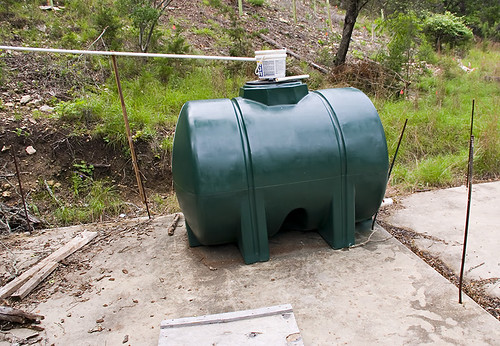
Good for Austin. My dad says his rain collectors are overflowing at the Land of Many Names, so they are figuring out how to make a massive garden there.
Austin attacks the problems of climate change -- right at home
This environmentally conscious city is already home to the headquarters of the Whole Foods organic grocery store chain, a new City Hall built mostly with recycled materials and a municipal electric utility that features solar cells on the roof of its parking lot. The Texas capital also pays residents rebates if they install extra attic insulation or high-efficiency clothes washers. There are steep discounts on rainwater collection barrels. Low-flow toilets are practically free. But those are just eco-baby steps compared with Austin's latest, and most ambitious, environmental quest: to lead the nation in slashing emissions of greenhouse gases that contribute to global warming. ...
Within five years, this fast-growing city of 680,000 intends to power 100 percent of its municipal facilities with renewable energy, such as solar or wind-driven power. Within eight years, every new home built in Austin will be required to be so energy efficient that, if an optional solar system is added to its roof, it will consume no more energy than it produces over the course of a year.
And by 2020, fully 30 percent of the city's total residential, commercial and industrial energy consumption is to be weaned from carbon dioxide-producing fossil fuels and shifted to clean, renewable sources -- a five-fold increase from current levels. Those carbon-reduction targets rank as the nation's most aggressive, environmental leaders say, outpacing efforts in Portland, Ore., Chicago and other cities that have set "green" agendas in recent years. [From In heart of Texas, drumbeat for green]
Austin has always been slightly ahead of the curve in re: environmental concerns. Must be that history of free-thinking anarchist/populists from central Europe who settled in the Texas Hill Country in the 1880s....
It's easier for Austin than for many cities to go green, not least because it's so blue. On electoral maps, the city always shows up as a stubbornly blue Democratic island in a bright red Republican state -- and Democrats, led by former Vice President Al Gore, have adopted global warming as a signature issue. Home to the flagship campus of the University of Texas and to numerous technology companies, Austin is the kind of eco-friendly town where thousands of locals journey downtown every evening to spread out picnic blankets and watch North America's largest urban bat colony take flight.and action is always preferable to talk, as in the case of Daley's faux-environmental pledges:
Other cities have struggled to fulfill green promises. Chicago Mayor Richard Daley, for example, earned international praise from environmentalists when he pledged in 2001 that within five years the city would buy 20 percent of its electricity from renewable sources and curb its emissions of greenhouse gases by 4 percent.In the long run, green buildings are better:
In reality, the Tribune found, by the end of last year Chicago's greenhouse emissions had increased 10 percent from a baseline average from 1998 to 2001. And the city had not purchased any green energy since 2004.
But Austin officials are confident they can meet their pioneering goal of powering nearly a third of the city's energy from renewable sources by 2020. (Today, that figure is 6 percent.) Partly that's because Austin owns its municipal electric utility -- an increasingly rare arrangement in an era of utility privatization -- which allows city leaders to drive energy policies. That's why Duncan, the city's chief authority on renewable energy, was able to order the installation of a bank of solar panels atop the parking lot beneath his office window as a demonstration project. And it's why Austin Energy subsidizes more than half the cost when homeowners agree to install $20,000 solar systems.
City leaders figure such a subsidy makes sense because reduced electricity demand means they will not have to build more power plants. Wind power is even more promising, city officials say. Texas already leads the nation in new wind farms, and Austin is driving demand for even more. Last year, when the city offered a fresh batch of wind-driven power contracts to consumers -- at a lower cost than electricity generated from natural gas -- the offering was so popular that a televised lottery was held to pick the winners.
Ultimately it's those kinds of bottom-line economic benefits, rather than feel-good politics, that will drive more consumers into the green camp, Austin officials maintain. In the hot central Texas climate where water is scarce and electricity is expensive, Wynn is certain that energy-efficient houses that promise sharply lower utility bills will be in increasing demand, even if they cost more upfront to build or retrofit.

Good afternoon, Seth. 'Tis my manual trackback on this great article. I loved it. Maybe we can recycle Texan B.S. in D.C. Then we are in full business.
If the city continues to replace 90 and 150W streetlights with 250W ones there is no way we'll be able to reduce city electricity use. They could be replacing the streetlights with efficient fully-shielded lights (that would send the light hitting second and third floor windows back down to the ground) and reduce the wattage on the bulb, and still get more light on the ground.
The shielded streetlight issue has long troubled me. I don't see the reason for *not* using shielded lights, other than laziness in purchasing practices, or worse (politically connected suppliers). I'm too lazy to look it up now to see if was pseudo-science or not, but I've read about melatonin levels in urban dwellers being lower than average because of all the excess light city dwellers encounter. Not to mention the loss of astronomy opportunities.